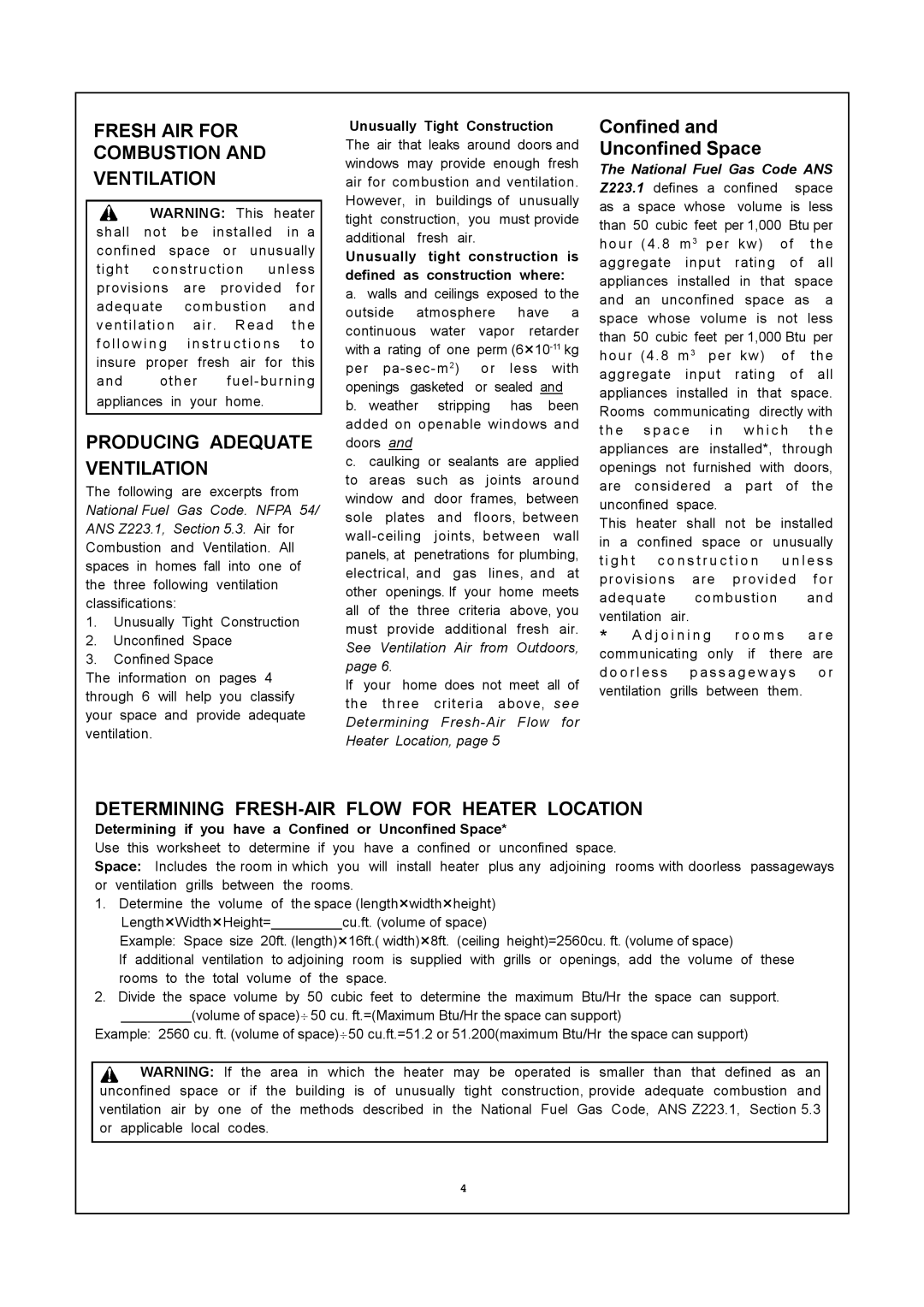
FRESH AIR FOR
COMBUSTION AND
VENTILATION
| WARNING: This | heater | |||
shall | not | be installed | in a | ||
confined space | or unusually | ||||
tight | construction | unless | |||
provisions | are | provided | for | ||
adequate | combustion |
| and | ||
ventilation | air. | Read | the | ||
follow in g in stru ctio ns | to | ||||
insure proper fresh air for this
and other
PRODUCING ADEQUATE VENTILATION
The following are excerpts from National Fuel Gas Code. NFPA 54/ ANS Z223.1, Section 5.3. Air for Combustion and Ventilation. All spaces in homes fall into one of the three following ventilation classifications:
1.Unusually Tight Construction
2.Unconfined Space
3.Confined Space
The information on pages 4 through 6 will help you classify your space and provide adequate ventilation.
Unusually Tight Construction
The air that leaks around doors and windows may provide enough fresh air for combustion and ventilation. However, in buildings of unusually tight construction, you must provide additional fresh air.
Unusually tight construction is defined as construction where:
a.walls and ceilings exposed to the outside atmosphere have a
continuous water vapor retarder with a rating of one perm
b.weather stripping has been added on openable windows and doors and
c.caulking or sealants are applied to areas such as joints around window and door frames, between sole plates and floors, between
If your home does not meet all of the three criteria above, see Determining
Confined and
Unconfined Space
The National Fuel Gas Code ANS
Z223.1 defines a confined space as a space whose volume is less than 50 cubic feet per 1,000 Btu per hour (4.8 m3 per kw) of the aggregate input rating of all appliances installed in that space and an unconfined space as a space whose volume is not less than 50 cubic feet per 1,000 Btu per hour (4.8 m3 per kw) of the aggregate input rating of all appliances installed in that space. Rooms communicating directly with
th e sp ac e | in w h ic h th e |
appliances are | installed*, through |
openings not furnished with doors, are considered a part of the unconfined space.
This heater shall not be installed in a confined space or unusually
tig h t c o n s tru c t io n | u n le ss | ||||
provisions are | provided | for | |||
adequate | combustion | and | |||
ventilation | air. |
|
|
| |
* | A d j o i n in g | r o o m s | a r e | ||
communicating only if | there | are | |||
d o o rless | p ass ag e w ays | o r | |||
ventilation | grills between | them. |
| ||
DETERMINING FRESH-AIR FLOW FOR HEATER LOCATION
Determining if you have a Confined or Unconfined Space*
Use this worksheet to determine if you have a confined or unconfined space.
Space: Includes | the room in which you will install heater plus any adjoining rooms with doorless passageways | |||||||||
or | ventilation | grills between | the rooms. | × | × |
| ||||
1. | Determine | the | volume of | the space (length |
| |||||
| width height) |
| ||||||||
| × |
| × | Height= |
|
| cu.ft. (volume of space) |
| ||
| Length Width |
|
|
| ||||||
|
|
|
|
|
| × |
| × | height)=2560cu. ft. (volume of space) | |
| Example: Space size 20ft. (length) 16ft.( width) 8ft. (ceiling | |||||||||
| If additional ventilation to adjoining room is | supplied with | grills or openings, add the volume of these | |||||||
| rooms to | the | total volume of the space. |
|
|
| ||||
2.Divide the space volume by 50 cubic feet to determine the maximum Btu/Hr the space can support. (volume of space)÷50 cu. ft.=(Maximum Btu/Hr the space can support)
Example: 2560 cu. ft. (volume of space)÷50 cu.ft.=51.2 or 51.200(maximum Btu/Hr the space can support)
![]() WARNING: If the area in which the heater may be operated is smaller than that defined as an unconfined space or if the building is of unusually tight construction, provide adequate combustion and
WARNING: If the area in which the heater may be operated is smaller than that defined as an unconfined space or if the building is of unusually tight construction, provide adequate combustion and
ventilation air | by one of the methods described in the National Fuel Gas Code, ANS Z223.1, Section 5.3 |
or applicable | local codes. |
4
